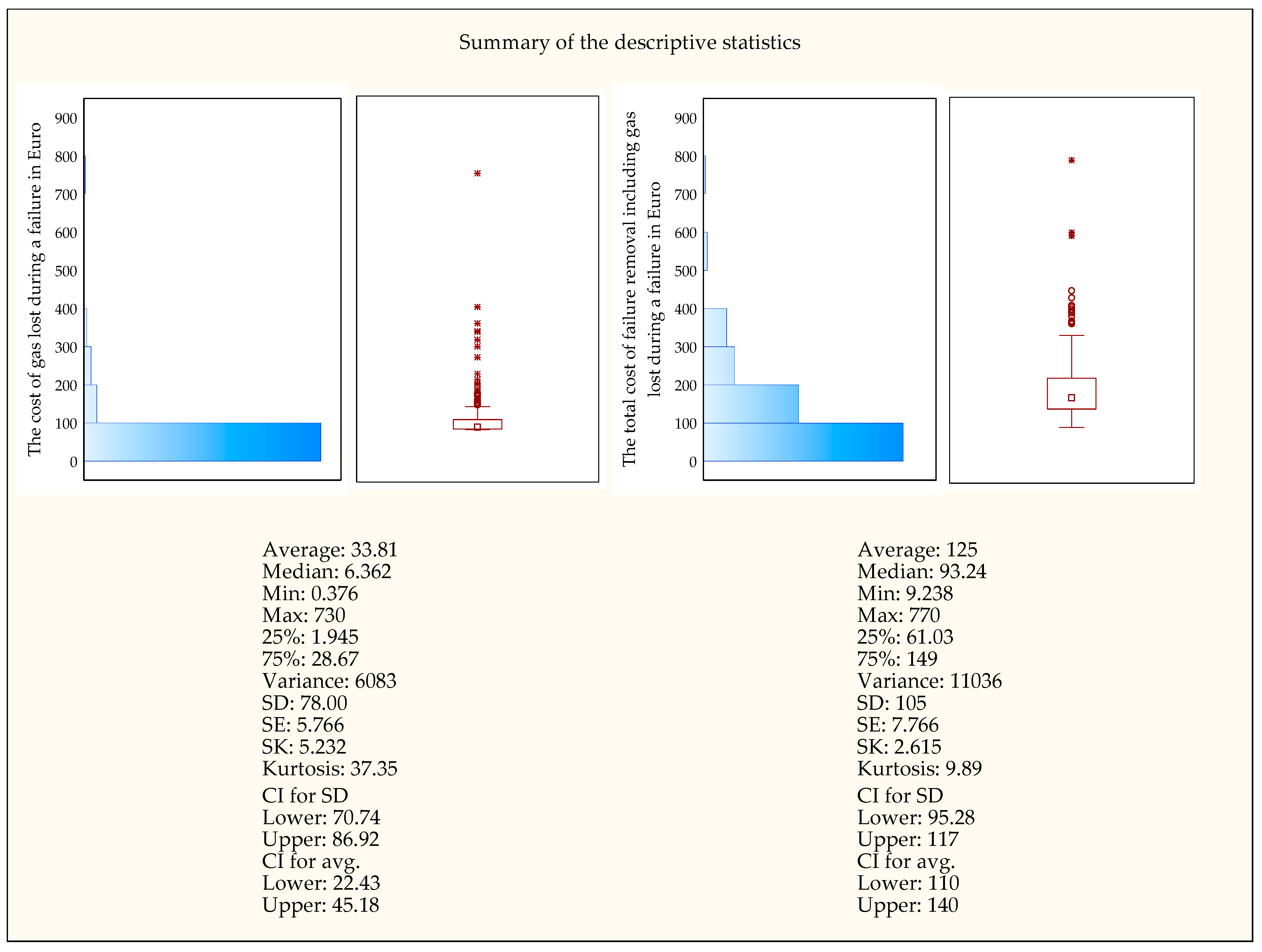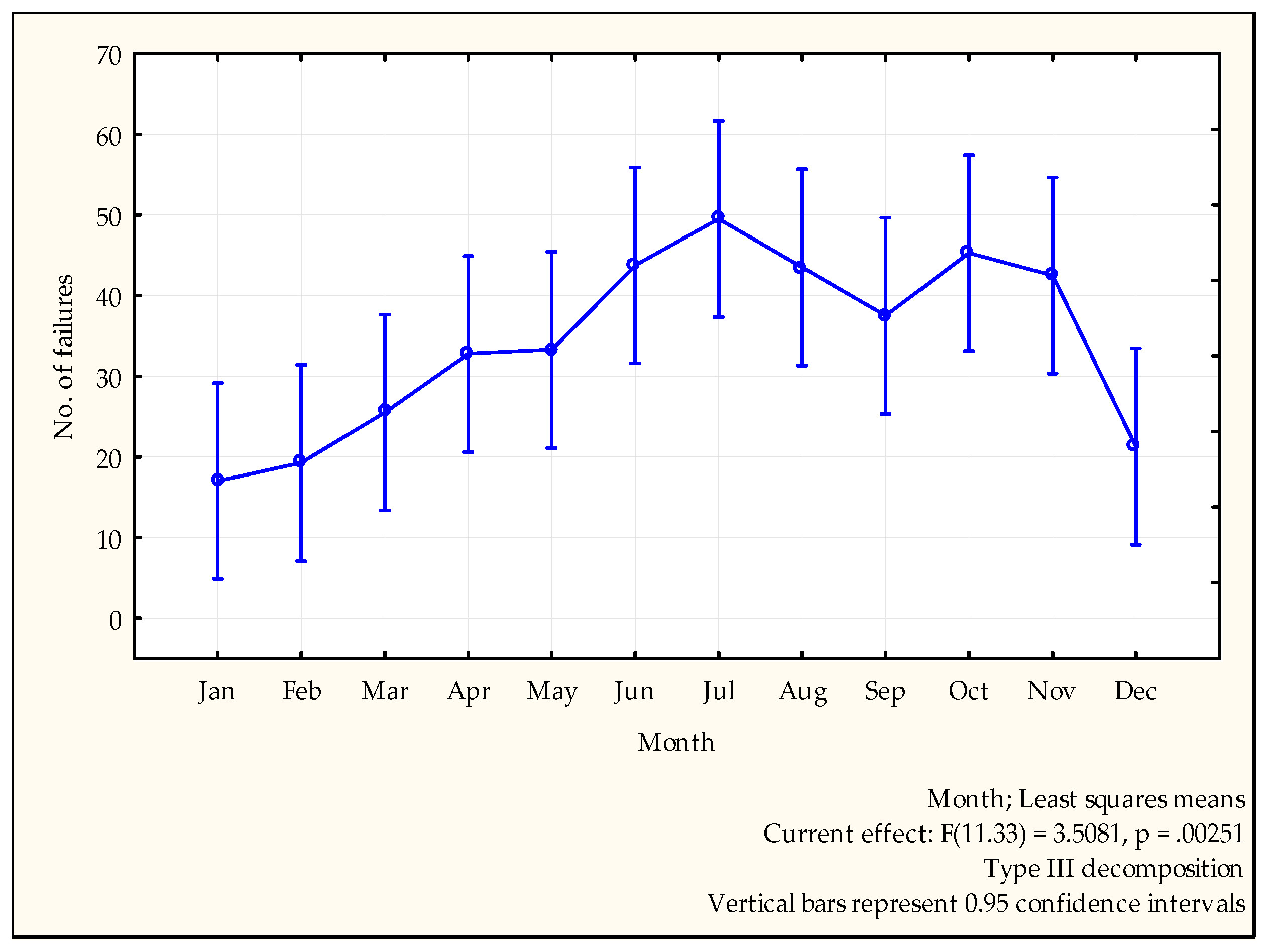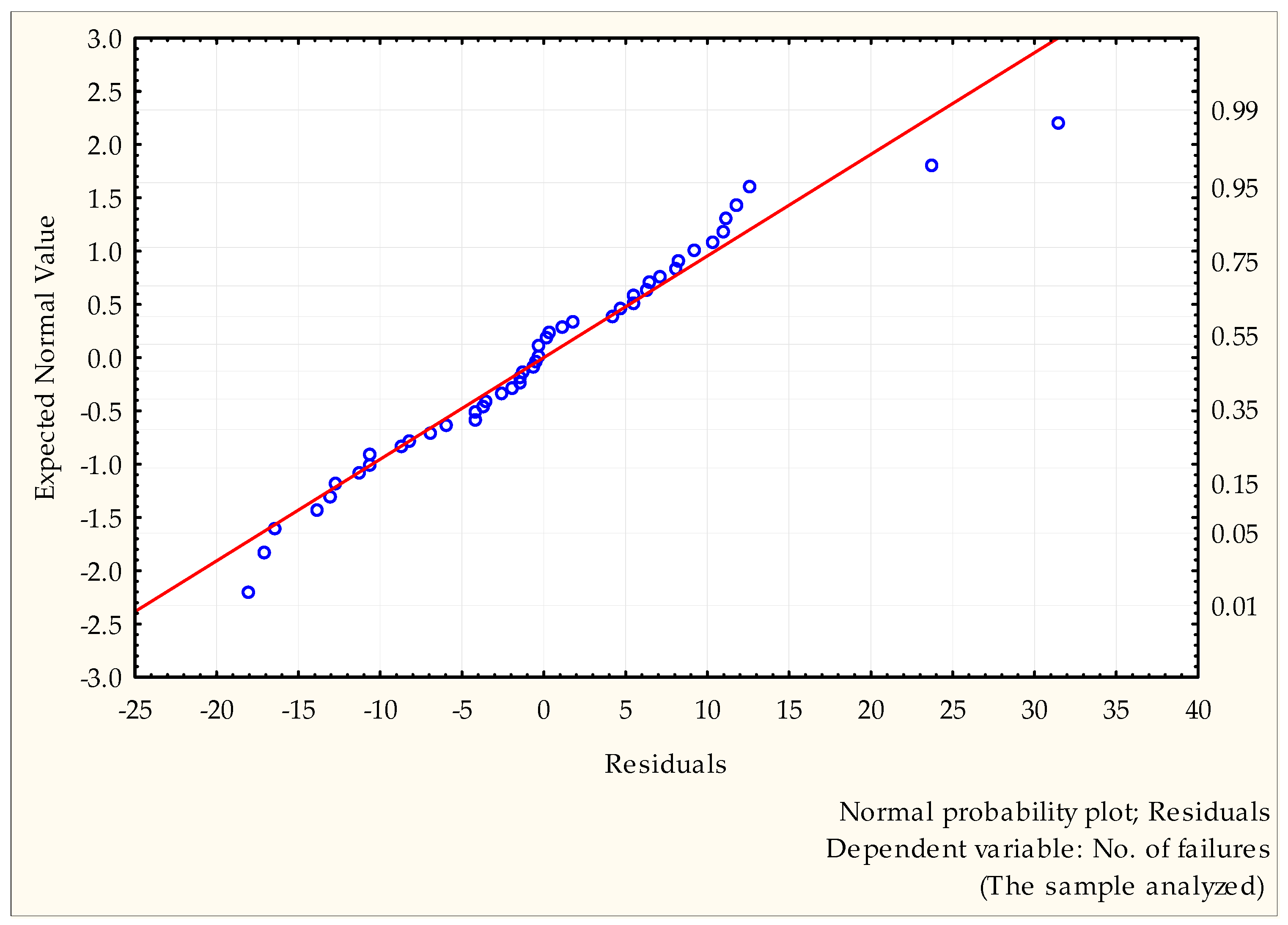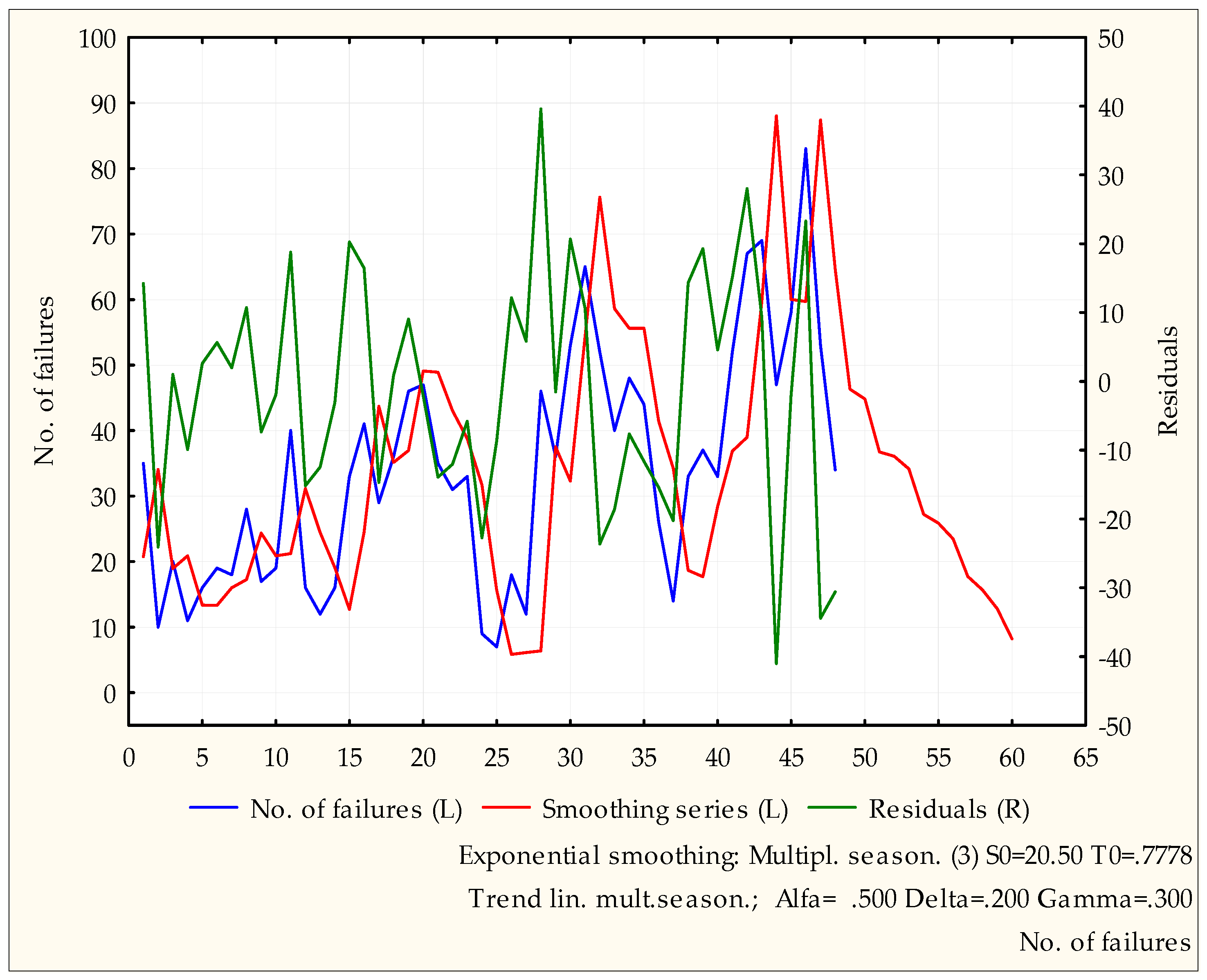Analysis of the Safety of Functioning Gas Pipelines in Terms of the Occurrence of Failures
Abstract
1. Introduction
2. Estimation of the Average Failure Cost of Gas Pipelines
Obtained Results
3. Assessment of the Level of Integrated Risk to the Gas-Supply Subsystem Using the Risk Area Identification Method
- w is a coefficient dependent on the gas leak:
- -
- No gas leak (with point weight 1);
- -
- A gas leak (with point weight 2).
- k is the location class for the gas pipeline according to the existing regulation concerning the technical conditions to be met by gas networks and their location:
- -
- First class of location—area with a shared residence and public utility buildings, single- or multi-family buildings, intensive vehicular traffic, and developed underground infrastructure, such as water supply, sewage, heating, gas, power and telecommunications, streets/roads, and mining areas (with point weight 3);
- -
- Second class of location—single-family and farm buildings, or developments with individual recreation buildings, as well as infrastructure necessary for them (with point weight 2);
- -
- Third class of location—an undeveloped area or an area where only single-family, farm and livestock buildings and the infrastructure necessary for them can be found (with point weight 1).
- s is a factor expressing the impact of the failure on the environment (s):
- -
- Little impact (with point weight 1);
- -
- Significant impact (with point weight 2);
- -
- Very significant impact (with point weight 3).
- -
- Material ageing (compensator failure, leaks from fittings, pipe crack);
- -
- Improper performance (gas pipeline corrosion, pipe crack, formation of hydrates);
- -
- Material defect (compensator failure, leaks from fittings, pipe crack, gas pipeline corrosion);
- -
- Improper gas composition (gas pipeline corrosion, formation of hydrates, ice caps, false alarm);
- -
- Terrorist attack (pipe crack);
- -
- Investment works (pipe crack, false alarm);
- -
- Geological conditions (compensator failure, leaks from fittings, pipe crack).
- -
- S1—the blocking of transport routes: Pipeline in non-urbanized areas (1), pipeline in pedestrian traffic, under pavements (2), or pipeline in the street (3),
- -
- S2—devastation of nature associated with the removal of the defect: Little or no impact, restitution time below 1 year, and the cost of restitution below 103 EUR (1); or local impact, restitution time over 1 year, and the cost of restitution over 103 EUR (2); and big, restitution time above 10 years, and the cost of restitution over 105 EUR (3),
- -
- S3—a break in the supply of thermal energy during heating season: Up to 4 h (1), from 4 to 6 h (2), or more than 6 h (3),
- -
- S4—devastation of infrastructure related to the removal of the defect: Financial loss of up to 103 EUR (1), financial loss from 103 to 104 EUR (2), or financial loss above 104 EUR (3),
- -
- S5—disturbed production processes in industrial plants: Financial loss of up to 103 EUR (1), financial loss from 103 to 104 EUR (2), or financial loss above 104 EUR (3),
- -
- S6—a break in the supply of electricity, up to 2 h (1), from 2 to 6 h (2), or more than 6 h (3),
- -
- S7—dissatisfaction on the part of individual recipients: No or incidental consumer complaints (1), numerous complaints and notifications in public media (2), broad information in local and national media (3).
- -
- S8—evacuation of residents: Evacuation of 100 inhabitants (1), evacuation of 101 to 300 inhabitants (2), or more than 301 residents evacuated (3);
- -
- S9—material losses caused by a gas explosion: Financial loss of up to 104 EUR (1), financial loss from 104 to 106 EUR (2), or financial loss above 106 EUR (3);
- -
- S10—losses of life and health caused by a gas explosion: Required medical assistance (1); required hospitalization (2); or fatal descent (3);
- -
- S11—toxic contamination due to the escape of gas: Local impact (1), national impact (2), or international impact (3),
- -
- S12—toxic contamination by combustion gases (gas explosion): Local impact (1), national impact (2), or international impact (3);
- -
- S13—contribution to the greenhouse effect: Negligible (1), significant (2), or critical (3).
- -
- In the case of an insignificant risk (also definable as tolerable) being obtained (r < 50), no further action is required and the system is being operated in a proper and reliable way;
- -
- A controlled risk (r from 51 to 115) means that the system is allowed to operate, but under the condition that modernization or repair work will be undertaken;
- -
- If risk at an unacceptable level has arisen (r above 116), immediate action will have to be taken to reduce this.
Application Example
- -
- Type depending on pressure—medium-pressure gas pipeline;
- -
- Gas pipeline material—PE (polyethylene);
- -
- Location—areas with single-family housing.
4. Network Failure Forecasting Through Regressions with Delay
5. Conclusions and Perspectives
Author Contributions
Funding
Acknowledgments
Conflicts of Interest
Appendix A
References
- Kent Muhlbauer, W. Pipeline Risk Management; Gulf Publishing Company: London, UK, 1992. [Google Scholar]
- Lu, W.; Su, M.; Fath, B.D. A systematic method of evaluation of the Chinese natural gas supply security. Appl. Energy 2016, 165, 858–867. [Google Scholar] [CrossRef]
- Shalaby, H.M.; Riad, W.T.; Alhazza, A.A.; Behbehani, M.H. Failure analysis of fuel supply pipeline. Eng. Fail. Anal. 2006, 13, 789–796. [Google Scholar] [CrossRef]
- Dröge, M.T.; Kenter, R. European Gas Pipeline Incident Data Group (EGIG). In 9th Reports of the European Gas Pipeline Incident Data Group (Period 1970–2013); Doc. No EGIG 14.R.0403; European Gas Pipeline Incident Data Group (EGIG): Amsterdam, The Netherlands, 2015; Available online: https://www.egig.eu/startpagina/$61/$156 (accessed on 12 June 2019).
- Dieckhoener, C.; Lochner, S.; Lindenberger, D. Simulating the Effects of European Natural Gas Infrastructure Developments. Oil Gas-Eur. Mag. 2010, 36, 174–185. [Google Scholar]
- Tchórzewska-Cieślak, B.; Pietrucha-Urbanik, K.; Urbanik, M.; Rak, J.R. Approaches for Safety Analysis of Gas-Pipeline Functionality in Terms of Failure Occurrence: A Case Study. Energies 2018, 11, 1589. [Google Scholar] [CrossRef]
- Marcogaz—Technical Association of the European Natural Gas Industry; Report on European Gas Safety; Gas Distribution (EGAS B): Brussels, Belgium, 2017.
- Montiel, H.; Vilchez, J.A.; Amaldos, J.; Casal, J. Historical analysis of accidents in the transportation of natural gas. J. Hazard. Mater. 1996, 51, 77–92. [Google Scholar] [CrossRef]
- Bianchini, A.; Guzzini, A.; Pellegrini, M.; Saccani, C. Natural gas distribution system: A statistical analysis of accidents data. Int. J. Press. Vessel. Pip. 2018, 168, 24–38. [Google Scholar] [CrossRef]
- Giovanni Ramírez-Camacho, J.; Carbone, F.; Pastor, E.; Bubbico, R.; Casal, J. Assessing the consequences of pipeline accidents to support land-use planning. Saf. Sci. 2017, 97, 34–42. [Google Scholar] [CrossRef]
- Hemmatian, B.; Abdolhamidzadeh, B.; Darbra, R.M.; Casal, J. The significance of domino effect in chemical accidents. J. Loss Prev. Process Ind. 2014, 29, 30–38. [Google Scholar] [CrossRef]
- Chmielowski, K.; Bugajski, P.; Maziarz, J. Analysis of failure events occurring in the gas networks based on the example of the Gas Company in Jasło. Gas Water San. Tech. 2017, 4, 136–139. [Google Scholar]
- Brown, N.; Crate, J.M. Analysis of a failure in a polyethylene gas pipe caused by squeeze off resulting in an explosion. J. Fail. Anal. Prev. 2012, 12, 30–36. [Google Scholar] [CrossRef]
- Wilmott, M.J.; Diakow, D.A. Factors influencing stress corrosion cracking of gas transmission pipelines: Detailed studies following a pipeline failure. Part 2: Pipe metallurgy and mechanical testing. Proc. Int. Pipeline Conf. 2016, 1, 573–585. [Google Scholar]
- Mazur, R.; Bedla, D.; Chmielowski, K.; Nowak, A.; Mazurkiewicz, J. The effect of oxygen condition on effectiveness of sewage treatment in submersible technology of nonwoven filters. Przem. Chem. 2016, 95, 1513–1517. [Google Scholar]
- Directive 2009/73/EC of the European Parliament and of the Council of 13 July 2009 Concerning Common Rules for the Internal Market in Natural Gas and Repealing Directive 2003/55/EC. Available online: https://eur-lex.europa.eu/legal-content/EN/ALL/?uri=CELEX%3A32009L0073 (accessed on 12 May 2018).
- Matvienko, A.F.; Filippov, Y.I.; Sagaradze, V.V.; Pecherkina, N.L.; Baldin, A.V.; Grigor’ev, P.A. Stress-corrosion cracking of steels for gas-main pipelines: III. Failure of pipes in the heat-affected zone. Phys. Met. Metallogr. 2000, 90, 309–317. [Google Scholar]
- Mohsin, R.; Majid, Z.A. Erosive failure of natural gas pipes. J. Pipeline Syst. Eng. 2014, 5, 818–837. [Google Scholar] [CrossRef]
- Urbanik, M.; Tchórzewska-Cieślak, B. Approach to the Determination of Failure Risk Level Index on the Example of the Natural Gas Distribution Subsystem. JCEEA 2017, 64, 305–312. [Google Scholar]
- Biresselioglu, M.E.; Yelkenci, T.; Oz, I.O. Investigating the natural gas supply security: A new perspective. Energy 2015, 80, 168–176. [Google Scholar] [CrossRef]
- Xiangpeng, L.; Shunli, L.; Jianfeng, S.; Xiang, L.; Jinyang, Z. Numerical simulation of strength failure of buried polyethylene pipe under foundation settlement. Eng. Fail. Anal. 2015, 48, 144–152. [Google Scholar] [CrossRef]
- Ondrejka Harbulakova, V.; Zelenakova, M.; Purcz, P. Selection of the Best Alternative of Heating System by Environmental Impact Assessment-Case Study. Envirionments 2018, 2, 19. [Google Scholar] [CrossRef]
- Fernandes, M.P.; Viegas, J.L.; Vieira, S.M. Segmentation of Residential Gas Consumers Using Clustering Analysis. Energies 2017, 10, 2047. [Google Scholar] [CrossRef]
- Ondrejka Harbulakova, V.; Estokova, A.; Kovalcikova, M. Correlation Analysis between Different Types of Corrosion of Concrete Containing Sulfate Resisting Cement. Environments 2017, 4, 44. [Google Scholar] [CrossRef]
- Tchorzewska-Cieslak, B. Estimating the acceptance of bearing the cost of the risks associated with the management of water supply system. Ochr. Srod. 2007, 29, 69–72. [Google Scholar]
- Tchórzewska-Cieślak, B. Water supply system reliability management. Env. Prot. Eng. 2009, 35, 29–35. [Google Scholar]
- Mohsin, R.; Majid, Z.A.; Yusof, M.Z. Multiple failures of API 5L X42 natural gas pipe: Experimental and computational analysis. Eng. Fail. Anal. 2013, 34, 10–23. [Google Scholar] [CrossRef]
- Urbanik, M.; Tchórzewska-Cieślak, B. Ecological aspects of the natural gas use. JCEEA 2015, 62, 409–417. [Google Scholar] [CrossRef]
- Hao, Y.-M.; Zhang, C.-S.; Shao, H.; Wang, M.-T. Baye network quantitative risk analysis for failure of natural gas pipelines. J. Northeast. Univ. 2011, 32, 321–325. [Google Scholar]
- Kuliczkowska, E. Analysis of defects with a proposal of the method of establishing structural failure probability categories for concrete sewers. Arch. Civ. Mech. Eng. 2015, 4, 1078–1084. [Google Scholar] [CrossRef]
- Krolikowska, J.; Debowska, B.; Krolikowski, A. An evaluation of potential losses associated with the loss of vacuum sewerage system reliability. Environ. Eng. 2013, 4, 51–57. [Google Scholar] [CrossRef]
- Kowalski, D.; Kowalska, B.; Kwietniewski, M. Monitoring of water distribution system effectiveness using fractal geometry. Bull. Pol. Acad. Sci. 2015, 63, 155–161. [Google Scholar] [CrossRef]
- Pluvinage, G.; Capelle, J.; Schmitt, C.; Mouwakeh, M. Domain failure assessment diagrams for defect assessment of gas pipes. In Proceedings of the 19th European Conference on Fracture: Fracture Mechanics for Durability, Reliability and Safety, Kazan, Russia, 26–31 August 2012. [Google Scholar]
- Rak, J.; Tchórzewska-Cieślak, B. The Possible Use of the FMEA Method to Ensure Health Safety of Municipal Water. J. Konbin 2010, 3, 143–154. [Google Scholar] [CrossRef]
- Potocnik, P.; Govekar, E.; Grabec, I. Short-term natural gas consumption forecasting. In Proceedings of the 16th Iasted International Conference on Applied Simulation and Modelling, Palma de Mallorca, Spain, 29–31 August 2007; pp. 353–357. [Google Scholar]
- Tchórzewska-Cieślak, B. Method of assessing of risk of failure in water supply system. European safety and reliability conference (ESREL), Risk, reliability and societal safety. Taylor Francis 2007, 2, 1535–1539. [Google Scholar]
- International Association of Oil & Gas Producers (OGP). Operating Management System Framework for Controlling Risk and Delivering High Performance in the Oil and Gas Industry; International Association of Oil & Gas Producers (OGP): London, UK, 2014. [Google Scholar]
- Martini, A.; Troncossi, M.; Rivola, A. Automatic Leak Detection in Buried Plastic Pipes of Water Supply Networks by Means of Vibration Measurements. Shock Vib. 2015, 2015, 165304. [Google Scholar] [CrossRef]
- Bajer, J. Economical and reliability criterion for the optimization of the water supply pumping stations designs. Env. Eng. 2013, 4, 21–28. [Google Scholar] [CrossRef]
- Polaskova, K.; Hlavinek, P.; Haloun, R. Integrated approach for protection of an urban catchment area. Desalination 2006, 1, 51–59. [Google Scholar] [CrossRef]
- Martini, A.; Troncossi, M.; Rivola, A. Leak Detection in Water-Filled Small-Diameter Polyethylene Pipes by Means of Acoustic Emission Measurements. Appl. Sci. 2017, 7, 2. [Google Scholar] [CrossRef]
- Jedlikowski, A.; Anisimov, S.; Danielewicz, J.; Karpuk, M.; Pandelidis, D. Frost formation and freeze protection with bypass for counter-flow recuperators. Int. J. Heat Mass Transf. 2017, 108, 585–613. [Google Scholar] [CrossRef]
- Piegdon, I.; Tchorzewska-Cieslak, B.; Szpak, D. The use of geographical information system in the analysis of risk of failure of water supply network. Environ. Eng. 2017, 5, 7–16. [Google Scholar]
- Rak, J.; Boryczko, K. Assessment of water supply diversification using the Pielou index. Environ. Eng. 2017, 5, 53–58. [Google Scholar]
- StatSoft, Inc. STATISTICA (Data Analysis Software System). Version 12. 2014. Available online: www.statsoft.com (accessed on 12 June 2019).
- IBM Knowledge Center. Approaches to Algorithms. Available online: https://www.ibm.com (accessed on 12 June 2019).
- Majid, Z.A.; Mohsin, R.; Yaacob, Z.; Hassan, Z. Failure analysis of natural gas pipes. Eng. Fail. Anal. 2010, 17, 818–837. [Google Scholar] [CrossRef]
- Majid, Z.A.; Mohsin, R.; Yusof, M.Z. Experimental and computational failure analysis of natural gas pipe. Eng. Fail. Anal. 2012, 19, 32–42. [Google Scholar] [CrossRef]
- Regulation of the Minister of Economy of 26 April 2013 on technical conditions to be met by gas networks and their location, OJ 2013, item 640. Available online: http://prawo.sejm.gov.pl/isap.nsf/download.xsp/WDU20130000640/O/D20130640.pdf (accessed on 12 June 2019).





| itgp | k | P | |||||||||||||
|---|---|---|---|---|---|---|---|---|---|---|---|---|---|---|---|
| 1 | 1 | 2 | 2 | 2 | 2 | … | 3 | 3 | 3 | 3 | 3 | 3 | 3 | ||
| w | |||||||||||||||
| 1 | 2 | 1 | 2 | 1 | 2 | … | 2 | 2 | 2 | 2 | 2 | 2 | 2 | ||
| ∑S1−S13 | |||||||||||||||
| 13 | 13 | 15 | 15 | 18 | 18 | … | 20 | 23 | 26 | 28 | 30 | 33 | 39 | ||
| 1 | 13 | 26 | 30 | 60 | 36 | 72 | . | 120 | 138 | 156 | 168 | 180 | 198 | 234 | |
| 1 | 2 | 26 | 52 | 60 | 120 | 72 | 144 | . | 240 | 276 | 312 | 336 | 360 | 396 | 468 |
| 3 | 39 | 78 | 90 | 180 | 108 | 216 | . | 360 | 414 | 468 | 504 | 540 | 594 | 702 | |
| 1 | 26 | 52 | 60 | 120 | 72 | 144 | . | 240 | 276 | 312 | 336 | 360 | 396 | 468 | |
| 2 | 2 | 52 | 104 | 120 | 240 | 144 | 288 | . | 480 | 552 | 624 | 672 | 720 | 792 | 936 |
| 3 | 78 | 156 | 180 | 360 | 216 | 432 | . | 720 | 828 | 936 | 1008 | 1080 | 1188 | 1404 | |
| 1 | 39 | 78 | 90 | 180 | 108 | 216 | . | 360 | 414 | 468 | 504 | 540 | 594 | 702 | |
| 3 | 2 | 78 | 156 | 180 | 360 | 216 | 432 | . | 720 | 828 | 936 | 1008 | 1080 | 1188 | 1404 |
| 3 | 117 | 234 | 270 | 540 | 324 | 648 | . | 1080 | 1242 | 1404 | 1512 | 1620 | 1782 | 2106 | |
| No. | Factors of A Given Gas Distribution Subsystem Group | Effect of Undesirable Event C | ||||
|---|---|---|---|---|---|---|
| w | with a gas leak | 2 | k | second class of location | 2 | |
| s | the blocking of transport routes | 3 | 12 | |||
| devastation of nature associated with the removal of the defect | 1 | 4 | ||||
| a break in the supply of thermal energy | 2 | 8 | ||||
| devastation of infrastructure related to the removal of the defect | 2 | 8 | ||||
| disturbed production processes in industrial plants | 3 | 12 | ||||
| a break in the supply of electricity | 2 | 8 | ||||
| dissatisfaction on the part of individual recipients | 2 | 8 | ||||
| evacuation of residents | 3 | 12 | ||||
| material losses caused by a gas explosion | 3 | 12 | ||||
| losses of life and health caused by a gas explosion | 3 | 12 | ||||
| toxic contamination due to the escape of gas | 3 | 12 | ||||
| toxic contamination by combustion gases (gas explosion) | 2 | 8 | ||||
| contribution to the greenhouse effect | 1 | 4 | ||||
| Σ | 120 | |||||
© 2019 by the authors. Licensee MDPI, Basel, Switzerland. This article is an open access article distributed under the terms and conditions of the Creative Commons Attribution (CC BY) license (http://creativecommons.org/licenses/by/4.0/).
Share and Cite
Urbanik, M.; Tchórzewska-Cieślak, B.; Pietrucha-Urbanik, K. Analysis of the Safety of Functioning Gas Pipelines in Terms of the Occurrence of Failures. Energies 2019, 12, 3228. https://doi.org/10.3390/en12173228
Urbanik M, Tchórzewska-Cieślak B, Pietrucha-Urbanik K. Analysis of the Safety of Functioning Gas Pipelines in Terms of the Occurrence of Failures. Energies. 2019; 12(17):3228. https://doi.org/10.3390/en12173228
Chicago/Turabian StyleUrbanik, Marek, Barbara Tchórzewska-Cieślak, and Katarzyna Pietrucha-Urbanik. 2019. "Analysis of the Safety of Functioning Gas Pipelines in Terms of the Occurrence of Failures" Energies 12, no. 17: 3228. https://doi.org/10.3390/en12173228
APA StyleUrbanik, M., Tchórzewska-Cieślak, B., & Pietrucha-Urbanik, K. (2019). Analysis of the Safety of Functioning Gas Pipelines in Terms of the Occurrence of Failures. Energies, 12(17), 3228. https://doi.org/10.3390/en12173228







